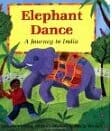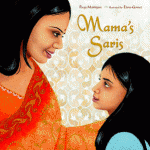 During my first visit to India, one of my son’s friends treated me to a musical concert in Bangalore. My congenial hostess and her friend candidly remarked that Americans have an erroneous impression about India. I listened attentively as they asked me if I had expected to see elephants walking in the city streets.
During my first visit to India, one of my son’s friends treated me to a musical concert in Bangalore. My congenial hostess and her friend candidly remarked that Americans have an erroneous impression about India. I listened attentively as they asked me if I had expected to see elephants walking in the city streets.
I chuckled. No, I did not expect to see any elephants unless I traveled into the countryside.
When I saw the cover of Elephant Dance: A Journey to India by Theresa Heine and illustrated by Sheila Moxley(Barefoot Books, 2004), I chuckled once again. Was a book that is intended to inform kids about modern India perpetuating this silly connection between elephants and India?
Until I started reviewing multicultural picture books, I never would have given the whimsical cover a second glance. The elephant prancing behind a young boy playing a flute goes hand-in-hand with the storyline that includes a young boy’s dream of causing an elephant to dance. The main focus of the story is the relationship between two young children and their grandparent while simultaneously providing a glimpse of life in India. While visiting his grandchildren in an undisclosed location outside India, the grandfather is asked a series of questions by his grandchildren. Sometimes the grandfather responds unnaturally.
Instead of focusing on a particular aspect of Indian culture, geography or climate, this book takes a smorgasbord approach. Using multicolored and playful drawings and an abundance of similes and metaphors, Theresa and Sheila expose the reader to a wide array of facts that are usually reserved for nonfiction books. A five page addendum includes additional information on geography, religion and culture, elephants, cobras, Bengal tigers, peacocks, Hanuman langur monkeys, Indian spices, and Indian foods. This book could easily be used as a springboard for a primary unit on India.
The background of the German born author is a mystery. A request for information from the publisher remains unanswered. The British illustrator’s background is recorded on her website. It is not known whether either spent any time in India.
Questions:
If neither spent any time in India, does it make the book any less authentic?
Do book covers convey hidden messages?
Multigenerational books with Indian themes:
See- https://sandrabornstein.com/teaching/intergenerational-picture-books-india
Talking Points:
- Literature focus- descriptive language (similes and metaphors)
- Vocabulary- Indian words
- Comparing foods and spices from different parts of the world
- Animal habitats
- Exploring holidays around the world
- Hinduism
- India’s climate and geography
- Relationships- child and grandparents
- Grandparents visiting living in another country
My western styled monochromatic clothing is no match for the stunning array of colors that grace Indian textiles. The saris illustrated in Mama’s Saris by, Pooja Makhijani and illustrated by Elena Gomez (Little Brown and Company, 2007) remind me of my fellow teachers who proudly wore bold patterned saris and traditional Indian outfits. I couldn’t help but feel out of place.
“Dressing up,” a childhood passion, is the recollection that prompted the writing of Mama’s Saris. Even though Pooja was raised in the U.S., she clings to her family’s Indian heritage.The book begins with an author’s note that describes different types of saris and follows with a useful glossary of Hindi words. Like many children, the main character wants to act like a “grown up” and pesters her mother to let her wear one of her saris. Small bits of Indian culture are revealed during the conversation between mother and daughter.
In the same year, another book was written with a similar theme:
My Dadima Wears a Sari by Kashmira Sheth. See https://sandrabornstein.com/teaching/intergenerational-picture-books-india
Talking Points:
- Mother-daughter relationships
- Customs from different countries
- Ceremonial dress
- Wanting to feel “grownup”
- Childhood desire to “dress up” in adult clothing
- Reaching milestones
Related Blogs:
10 Responses to My Teaching Abroad
Exploring Indian Culture at the British Museum
Picture Book- the Endangered Bengal Tiger
Intergenerational Picture Books India
Award Winning Picture Book- India
Sandra’s Bio

Leave a Reply
You must be logged in to post a comment.